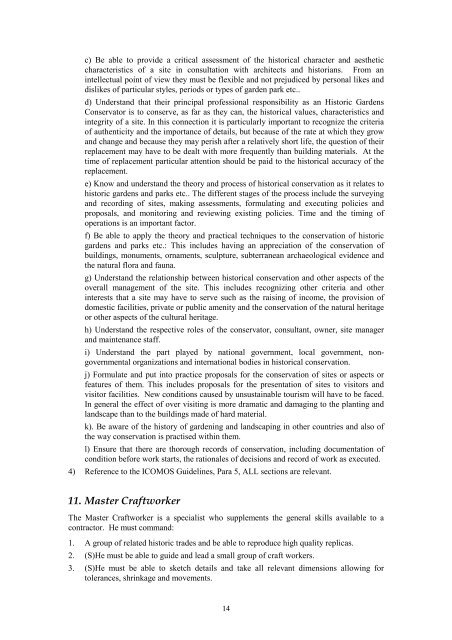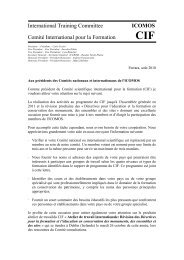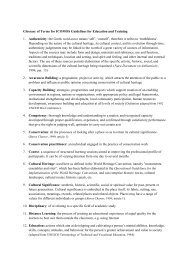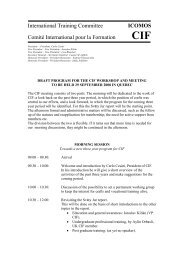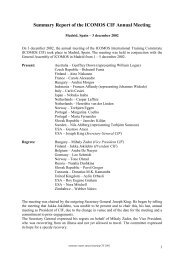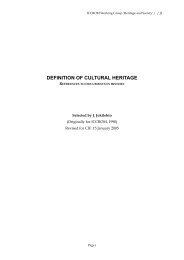COTAC Conference on Training in Architectural Conservation Multi ...
COTAC Conference on Training in Architectural Conservation Multi ...
COTAC Conference on Training in Architectural Conservation Multi ...
Create successful ePaper yourself
Turn your PDF publications into a flip-book with our unique Google optimized e-Paper software.
c) Be able to provide a critical assessment of the historical character and aesthetic<br />
characteristics of a site <strong>in</strong> c<strong>on</strong>sultati<strong>on</strong> with architects and historians. From an<br />
<strong>in</strong>tellectual po<strong>in</strong>t of view they must be flexible and not prejudiced by pers<strong>on</strong>al likes and<br />
dislikes of particular styles, periods or types of garden park etc..<br />
d) Understand that their pr<strong>in</strong>cipal professi<strong>on</strong>al resp<strong>on</strong>sibility as an Historic Gardens<br />
C<strong>on</strong>servator is to c<strong>on</strong>serve, as far as they can, the historical values, characteristics and<br />
<strong>in</strong>tegrity of a site. In this c<strong>on</strong>necti<strong>on</strong> it is particularly important to recognize the criteria<br />
of authenticity and the importance of details, but because of the rate at which they grow<br />
and change and because they may perish after a relatively short life, the questi<strong>on</strong> of their<br />
replacement may have to be dealt with more frequently than build<strong>in</strong>g materials. At the<br />
time of replacement particular attenti<strong>on</strong> should be paid to the historical accuracy of the<br />
replacement.<br />
e) Know and understand the theory and process of historical c<strong>on</strong>servati<strong>on</strong> as it relates to<br />
historic gardens and parks etc.. The different stages of the process <strong>in</strong>clude the survey<strong>in</strong>g<br />
and record<strong>in</strong>g of sites, mak<strong>in</strong>g assessments, formulat<strong>in</strong>g and execut<strong>in</strong>g policies and<br />
proposals, and m<strong>on</strong>itor<strong>in</strong>g and review<strong>in</strong>g exist<strong>in</strong>g policies. Time and the tim<strong>in</strong>g of<br />
operati<strong>on</strong>s is an important factor.<br />
f) Be able to apply the theory and practical techniques to the c<strong>on</strong>servati<strong>on</strong> of historic<br />
gardens and parks etc.: This <strong>in</strong>cludes hav<strong>in</strong>g an appreciati<strong>on</strong> of the c<strong>on</strong>servati<strong>on</strong> of<br />
build<strong>in</strong>gs, m<strong>on</strong>uments, ornaments, sculpture, subterranean archaeological evidence and<br />
the natural flora and fauna.<br />
g) Understand the relati<strong>on</strong>ship between historical c<strong>on</strong>servati<strong>on</strong> and other aspects of the<br />
overall management of the site. This <strong>in</strong>cludes recogniz<strong>in</strong>g other criteria and other<br />
<strong>in</strong>terests that a site may have to serve such as the rais<strong>in</strong>g of <strong>in</strong>come, the provisi<strong>on</strong> of<br />
domestic facilities, private or public amenity and the c<strong>on</strong>servati<strong>on</strong> of the natural heritage<br />
or other aspects of the cultural heritage.<br />
h) Understand the respective roles of the c<strong>on</strong>servator, c<strong>on</strong>sultant, owner, site manager<br />
and ma<strong>in</strong>tenance staff.<br />
i) Understand the part played by nati<strong>on</strong>al government, local government, n<strong>on</strong>governmental<br />
organizati<strong>on</strong>s and <strong>in</strong>ternati<strong>on</strong>al bodies <strong>in</strong> historical c<strong>on</strong>servati<strong>on</strong>.<br />
j) Formulate and put <strong>in</strong>to practice proposals for the c<strong>on</strong>servati<strong>on</strong> of sites or aspects or<br />
features of them. This <strong>in</strong>cludes proposals for the presentati<strong>on</strong> of sites to visitors and<br />
visitor facilities. New c<strong>on</strong>diti<strong>on</strong>s caused by unsusta<strong>in</strong>able tourism will have to be faced.<br />
In general the effect of over visit<strong>in</strong>g is more dramatic and damag<strong>in</strong>g to the plant<strong>in</strong>g and<br />
landscape than to the build<strong>in</strong>gs made of hard material.<br />
k). Be aware of the history of garden<strong>in</strong>g and landscap<strong>in</strong>g <strong>in</strong> other countries and also of<br />
the way c<strong>on</strong>servati<strong>on</strong> is practised with<strong>in</strong> them.<br />
l) Ensure that there are thorough records of c<strong>on</strong>servati<strong>on</strong>, <strong>in</strong>clud<strong>in</strong>g documentati<strong>on</strong> of<br />
c<strong>on</strong>diti<strong>on</strong> before work starts, the rati<strong>on</strong>ales of decisi<strong>on</strong>s and record of work as executed.<br />
4) Reference to the ICOMOS Guidel<strong>in</strong>es, Para 5, ALL secti<strong>on</strong>s are relevant.<br />
11. Master Craftworker<br />
The Master Craftworker is a specialist who supplements the general skills available to a<br />
c<strong>on</strong>tractor. He must command:<br />
1. A group of related historic trades and be able to reproduce high quality replicas.<br />
2. (S)He must be able to guide and lead a small group of craft workers.<br />
3. (S)He must be able to sketch details and take all relevant dimensi<strong>on</strong>s allow<strong>in</strong>g for<br />
tolerances, shr<strong>in</strong>kage and movements.<br />
14


